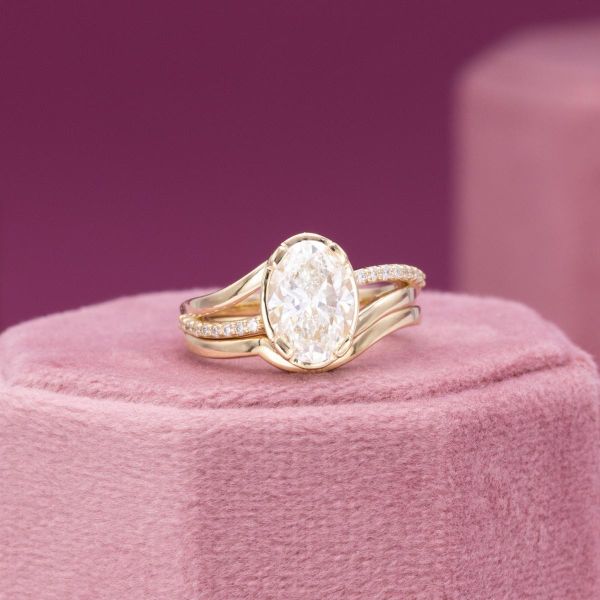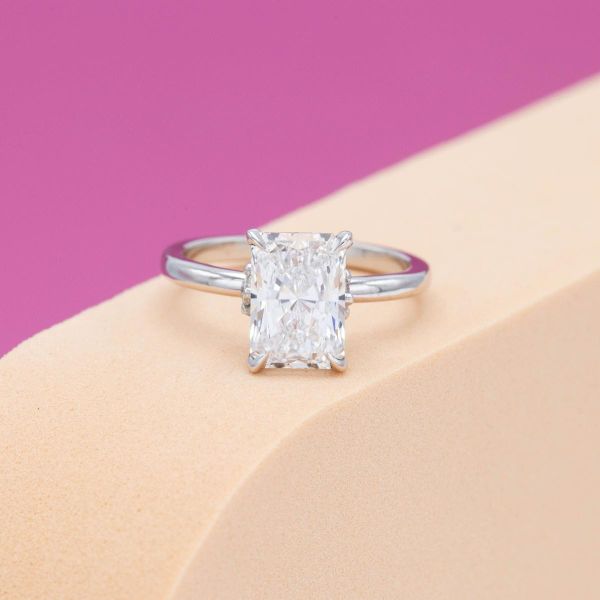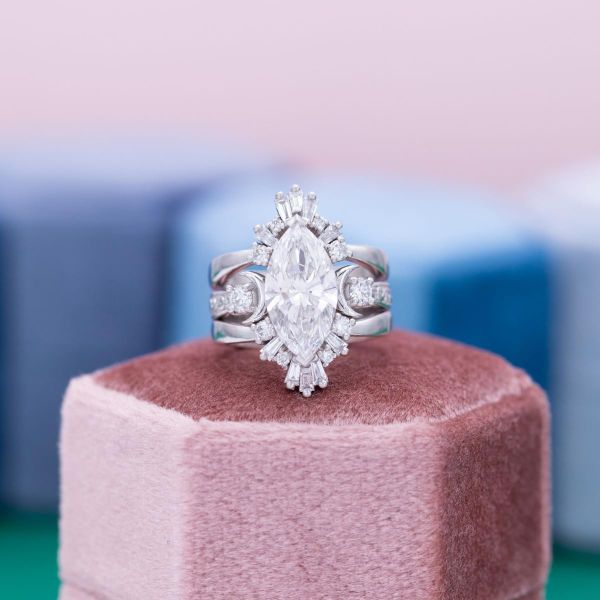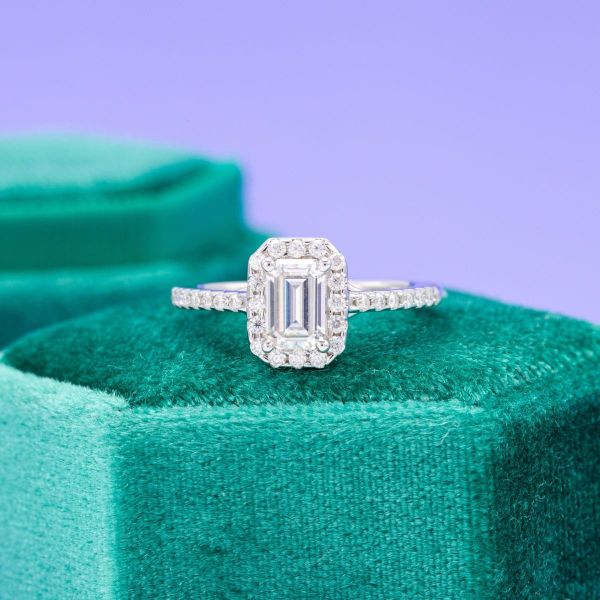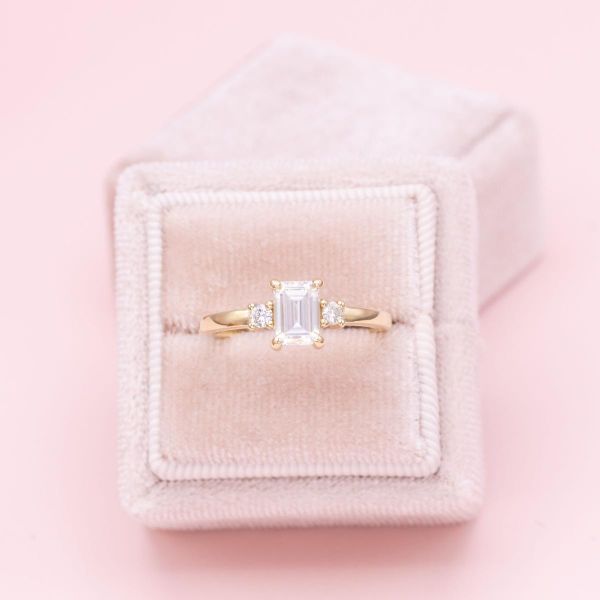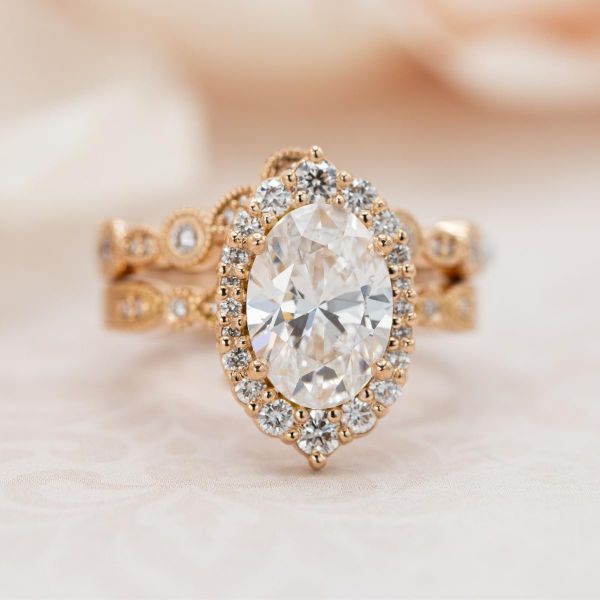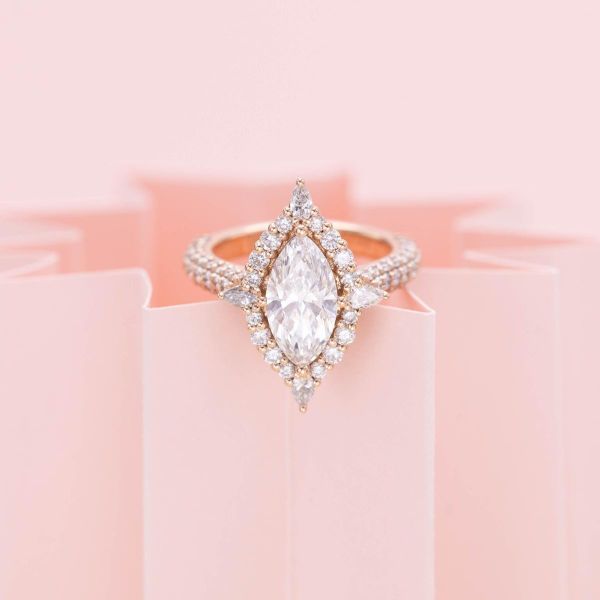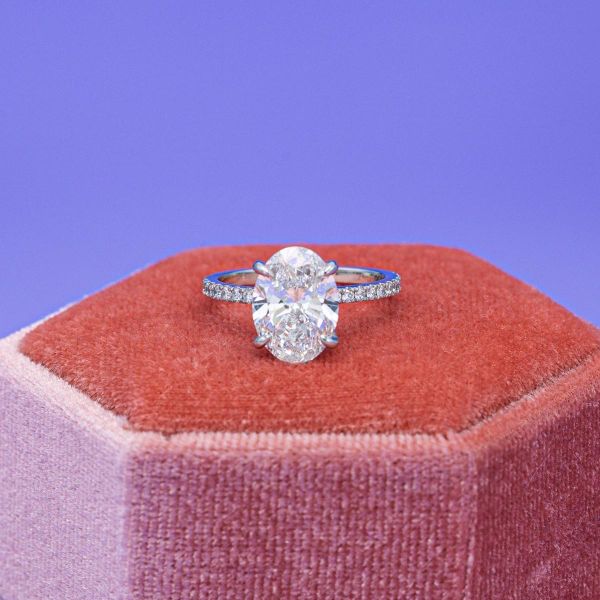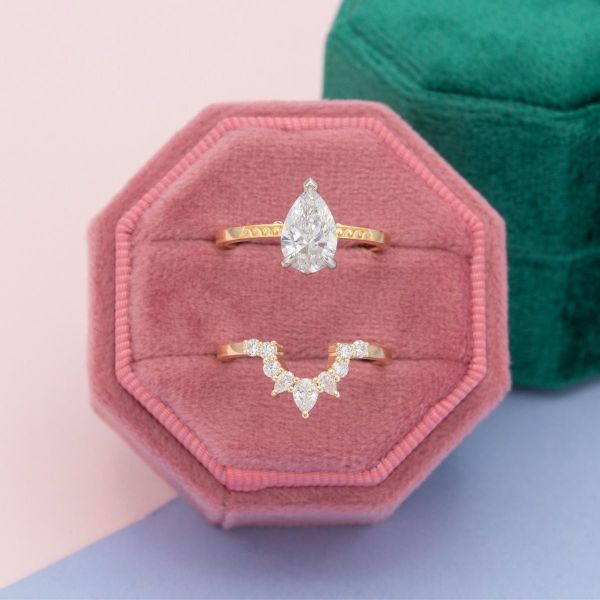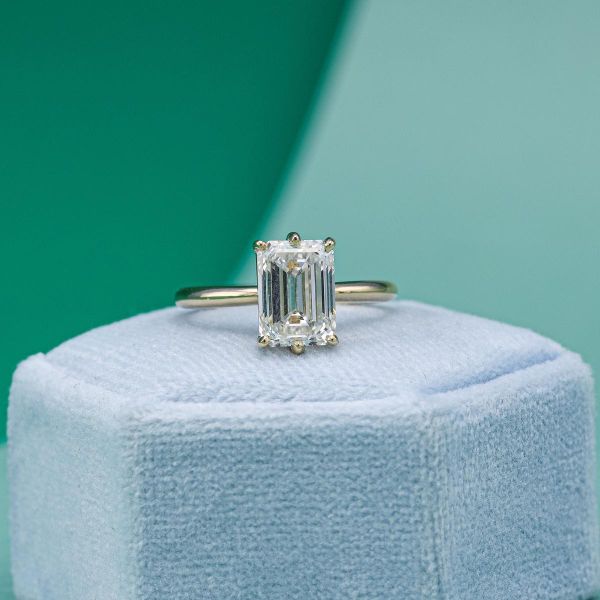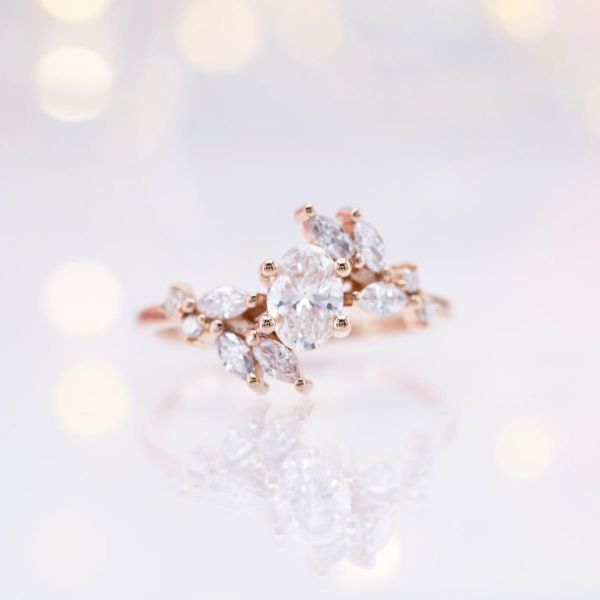Diamond Knowledge
How to pick the perfect lab diamond
A helpful guide to choosing the best color, cut, clarity, and more for your ideal lab-created diamond
Choosing your lab diamond
Lab diamonds are a true marvel, and it’s crazy to think that we can speed up the diamond’s billion year formation process to create high-quality stones on demand. It’s easy to see why these lab made beauties are a popular choice among engaged couples: they cost roughly 80% less than natural diamonds to fit most budgets, and their versatile nature means you can find them in almost any cut, shape, and color. But that leads us to a very important question: if there are so many options, how can you know which lab diamond is right for you?!
Just thinking about all of the choices to make when selecting “the” lab diamond for your ring can leave you spinning, but don’t worry! We’re here to provide practical guidance on how to pick your perfect lab diamond and create the engagement ring of you and your fiancée’s dreams.
The 4Cs of lab diamonds
The 4Cs provide guidelines for diamond grading that make finding your ideal stone much easier, and lab diamonds share many of their scales with natural ones. We’ve previously covered the 4Cs in detail, but here’s a little taste of how these criteria impact the lab diamond you should choose.
Cut
When assessing diamonds, cut is king! The cut grading scale ranges from Ideal to Poor for lab diamonds, and it measures the preciseness of the stone’s cut as it relates to maximizing fire, brilliance, and scintillation—all of the things we want from a glittering lab diamond! Note that this scale differs very slightly from the scale used for natural diamonds (Excellent to Poor) because the most popular rating agency for lab diamonds is IGI, rather than GIA, which is the primary source for natural diamond grades.
Luckily, most lab diamonds receive a high quality cut thanks to their man made nature. Because these diamonds typically grow without large inclusions that faceters have to work around, it’s easier to focus on the best cut possible for each stone. It’s not as easy for natural diamonds—which endure a much less predictable formation process—and consistently high-quality stones are rarer. So while lab diamonds usually have quality cuts, it takes a little more time—and a lot more money—to find a natural diamond with a similar quality cut.
If you’re shopping for a shape or cut other than a round brilliant, just know that most grading agencies (such as GIA) won’t offer a cut grade for “fancy shapes” (marquise, emerald, etc.), because there is no generally accepted standard of the perfect cut for these shapes. This matters less for lab diamonds as they’re usually high quality, but it’s just something to keep in mind as you peruse those grading reports!
Color
We know what you’re thinking: shouldn’t lab grown diamonds be perfect since they’re made in a lab? Not quite! Because the conditions used to create lab diamonds are so similar to the natural formation process, there’s plenty of room for small inclusions and a colored tint to appear as the diamond grows. But, as we mentioned before, they’re often still high quality, and this just reinforces the fact that they’re identical to their natural counterparts!
Lab diamonds receive a color grade ranging from D to Z according to their colorlessness. A D grade is the most colorless option, so think of it as a big “D” for Diamond! After all, most people are looking for that bright white sparkle, right?
If you’re thinking of a three stone, halo, or another setting with multiple lab diamonds, make sure you color match them so no single stone’s hue distracts from their seamless white sparkle. And keep in mind that a higher color grade the pricier the diamond, so the more you spend on a colorless diamond the less budget you’ll have for your ideal setting and the other 3Cs.
You can also partially mask any tint in a diamond’s color by choosing the right setting. White gold and platinum are perfect for diamonds with high color grades because the stones reflect their icy tones. But, yellow and rose gold are great for diamonds with slightly lower color grades, as reflections from these metals help mask the stone’s natural tint.
In addition to their signature white hue, lab diamonds also come in pink, blue, and yellow, and experts can create just about any shade you can think of. Add colored lab diamonds to your ring to signify a favorite color, or even just the way your fiancé brings color to your life!
Clarity
Experts use a clarity scale to grade a diamond’s imperfections, known as inclusions (inside the stone) and blemishes (on the surface of the stone). One last time: lab diamonds aren’t automatically perfect! It’s completely normal for them to contain a few small inclusions or slight discoloration. The scale for clarity ranges from Flawless (FL) to Included (I1-I3), accounting for the type, amount, size, and visibility of a diamond’s inclusions.
Lab diamonds typically have higher clarity grades, so this is an area where you may be able to make some wiggle room in your budget. Among the many possible clarity grades, what matters most is that the diamond is eye clean, which means you can’t see any inclusions with the naked eye. Because how many people are going to come up and look at your ring with a microscope, anyway?
Carat
We’ve all heard “go big or go home”, but that doesn’t always apply to lab diamonds. In reality, everyone wants something different out of their center stone. Big or small hands, long or short fingers, diamond shape—these are just a few of the factors that can change how big or small you might like your diamond to be.
Most couples choose a lab diamond in the 1 to 3 carat range, but you can find lab stones as large as 10 carats if you’re looking for something more glamorous. So, which size is right for you? We suggest trying on diamond rings with different carat weights to get a good feel for which one looks best on your hand. Some of us would love to be Elizabeth Taylor with her 33.1 carat rock, but we’d probably feel exhausted if we had to wear that heavy stone all day!
The larger the diamond, the easier it is to see its color and inclusions. So if you size up your stone, you may also have to increase your diamond's color and clarity grades to ensure it doesn't have any visible imperfections!
Shape and cut
We already mentioned that lab diamonds can come in just about any shape or cut you can imagine, but how they all sparkle is completely unique. Most popular cuts fit into two categories: brilliant and step. These cuts couldn’t look more different, and each shape takes on a life of its own! Let’s look at how each cut style sparkles so you can decide which one is right for your dream engagement ring.
Brilliant cuts
Brilliant cut diamonds have multiple facets that create prismatic sparkle for bright white flashes and hints of color, and they produce a “crushed ice” effect as you move the stone back and forth. In addition to making excellent center stones, they can easily complement the sparkle of colored and step cut gems as well, so their twinkling personalities are perfect for accents and side stones.
Most of us are familiar with the legendary round brilliant diamond, and this shape is a shining example of all the reasons couples love brilliant cuts! On top of being a well-rounded shape (ha, get it?) that suits any setting, its 58 facets maximize fire, brilliance, and scintillation for optimal sparkle.
But there are plenty of other “brilliant” silhouettes (alright, we’re done with the puns) to choose from if the round brilliant isn’t your style. Marquise, oval, and pear shaped stones are also incredibly popular, and brilliant cut princess shapes are ideal for anyone seeking a more geometric look.
Step cuts
Some couples prefer a subdued sparkle, but one that still exudes refinement and class from every facet. That’s where the step cut comes in! Step cut diamonds forego the classic diamond sparkle for something a little more understated. Their facets are long and often rectangular, acting as mirrors that give your lab diamond depth and produce on/off flashes of light with slight hints of colorful sparkle near their corners.
This softer appeal makes them perfect for side and accent stones, but they look particularly stunning at the center of solitaire settings. Step cut diamonds feature broader silhouettes like squares, rectangles, and octagons, and the most well-known option is the emerald cut. The long facets and cut corners of this stunning shape offer a soft, mirror-like shine that fits perfectly with vintage styles.
Baguette and Asscher cuts are also fantastic choices, and there are plenty more options if these shapes don’t suit your fancy!
You can always mix and match brilliant and step cut lab diamonds for a more complex sparkle. Take a look at these settings that take advantage of both the brilliant cut’s glittering display and the step cut’s mirror-like shine. Talk about having your (wedding) cake and eating it too!
Review each stone carefully
As you can see, there are several factors to keep in mind when shopping for your ideal lab diamond! Whether you want a sparkling white stone or something a little more colorful and vibrant, finding the right diamond for your needs takes some research.
The best thing you can do to ensure you find a quality stone is examine them—possibly with the help of a professional—to figure out what exactly you’re looking for. If you’re shopping online, take advantage of 360° images and videos to get an up close and personal look at each lab diamond you’re considering. You might even find something you like better than what you originally had in mind!
About CustomMade
CustomMade designs and creates one-of-a-kind, custom engagement rings and fine jewelry. Each piece we create is inspired by you, designed for you, and made just for you.
